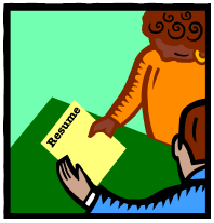From colors to format to content, creating a resume that correctly represents you can be time consuming, but it is very important to get it right. Your resume may have all of the essential information that employers are looking for, but if they can’t easily find it, you may risk  rejection. Part of the problem may be your format, while another issue may be that it is too cluttered and busy. You want your resume to look professional while conveying the skills that make you an attractive candidate. Take caution against providing too much information that could hurt your chances just as much as too little.
rejection. Part of the problem may be your format, while another issue may be that it is too cluttered and busy. You want your resume to look professional while conveying the skills that make you an attractive candidate. Take caution against providing too much information that could hurt your chances just as much as too little.
If your resume looks too busy and text-heavy, it’s time to do some decluttering and free up some white space. Your resume should be visually appealing and have a balance of white space and text so that readers can easily scan through without being overwhelmed. Here are a few tips to take into consideration when writing your resume.
Cut unnecessary words. You do not want your resume to be too wordy. A prospective employer should be able to easily read through it and get a good understanding of your job skills.
Condense old jobs. If you held the job more than 10 years ago, you can probably condense it to just the company, position, and years. If you had a noteworthy accomplishment or two you can add them in bullet points, but typically more current positions give a better impression of your abilities.
Use clear headers. This again helps with the flow and look of the resume, as well as helping employers find the information they are looking for.
Know your goal. What type of job are you looking for? Before you can begin crafting and tailoring your resume, you need to have a clear focus in mind. This will help you in determining what information to keep and what to cut when editing your resume.
Find a common theme. What strengths and abilities are required for the job you want? Once you have come up with a list of keywords and skills, go back through your work history and start making connections. Highlight the accomplishments and projects from each job that align with the overall theme and message you want to send.
What did you gain from the position? This may take some thought. Consider each job and what you gained from it that contributes to your qualifications for your current career. Try to look at the bigger picture.
Include metrics. Where applicable, include metrics and quantifiable results. This gives more solid proof of a job well done. It can help to show that you are able to meet and exceed expectations and produce results.
Skip short-term jobs that hold little value. If you worked a summer as a waitress or at the local grocery store just to make extra money and it does not relate at all to your career, you may benefit from excluding this from your resume. As long as it does not leave a significant gap in employment, it adds little benefit and takes up valuable space. If the job will cause a noticeable gap, explain the position as concisely as possible and move on. No need to elaborate on details irrelevant to your current career.
Make sure your resume doesn’t read like a generic job description. It should be about what you’ve accomplished.
Use a consistent font: Make sure the font you use is pleasing to the eye, easy to read, and available on most computers. Just keep it clean and simple and use the same font style throughout your resume. The font size should be consistent. With the exception of the resume title, which could be larger.
These are just a few tips to get your resume in working order. It is usually the first impression an employer gets to see when you apply for a job. Make sure it shows how qualified you are, so you get that first interview call!